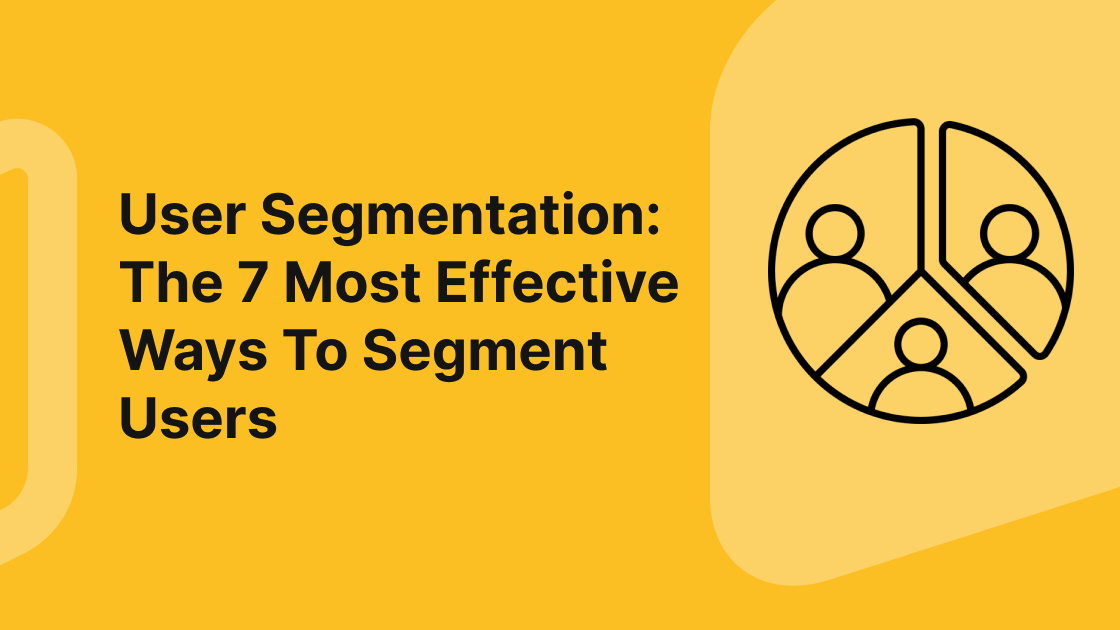Want to up your user segmentation game? We’ve got you covered. In this guide, we’ll explore the 7 most effective types of user segmentation with examples.
To make a great mobile app, you need to know your users inside and out. One way to do this is through user segmentation, where you group users based on shared characteristics like age, interests, and behavior. By doing this, you'll get a better understanding of what each group wants from your app, which can have lots of positive effects such as:
-
Increase email campaign open and click-through rates (Mailchimp)
-
A higher return on promoted sales (McKinsey)
-
Identify best-fit customers (Royal Mint)
-
Break into new markets
-
Reduce customer acquisition costs
It's like putting on different glasses to see your users more clearly - you can get a closer look at what makes them tick and what they need from your app.
In this article, we'll take a deep dive into the world of user segmentation, exploring the different models available, and providing practical advice on how to implement a segmentation strategy that drives growth and engagement. Let’s dive in.
What is user segmentation?
User segmentation is the process of splitting users into different groups based on how they use your product. This helps you understand their usage patterns better.
Let's say you have a subscription app that offers meal-planning services. You might segment your users into groups based on factors like age, dietary restrictions, and fitness goals. Then, you can send targeted campaigns to each group promoting recipes and meal plans that are specifically tailored to their needs.
User segmentation can also help you identify areas for improvement in your app. For example, if you notice that one group of users tends to drop off after a certain point in the onboarding process, you can dig deeper into why that might be happening and make adjustments to improve their experience.
Overall, the goal of user segmentation is to create a more personalized experience, shorten the time-to-value, and foster deeper product adoption. All of which will lead to higher retention rates, increased revenue, and a stronger, more active user base.
7 most effective user segmentation models
There is no fixed number of ways to segment users. It can vary on the specific needs of a business and the characteristics of its user base. However, there are several commonly used segmentation models. Let’s take a look at them.
1 - Demographic segmentation
Demographic segmentation is a way for businesses to group their customers according to characteristics like age, gender, income, education, and job. It's popular amongst businesses because these characteristics often give an idea of how the customer might behave or what they like.
Example of demographic segmentation:
Let's say an e-commerce mobile app’s data shows that users between the ages of 18 and 25 are its most active users. The app might create a marketing campaign that features products and promotions targeted at this age group, such as college dorm room essentials or trendy clothing. On the other hand, if the app's data shows that its highest-paying users are middle-aged women, it might create a marketing campaign featuring luxury goods and beauty products that appeal to this demographic.
2 - Geographic segmentation
Geographic segmentation is all about grouping users based on where they live. You can divide your user base into segments based on their location, like the country, state, city, or zip code. But the real value of geographic segmentation is what it tells you about important variables like culture, language, and population density. These insights can help you create more effective marketing campaigns and offer tailored product experiences that resonate with your users.
Example of geographic segmentation:
A mobile app that offers a food delivery service might use geographic segmentation to identify the most popular types of food and delivery options in different cities. If the app's data shows that users in a particular city prefer spicy food and have a high demand for quick delivery times, the app could create a marketing campaign featuring spicy food options and faster delivery times for that specific city.
Or say an e-commerce app uses geographic segmentation to offer different products based on regional differences. If the app has users in both hot and cold climates, it might feature different products such as winter clothing and accessories for users in cold regions, and summer clothes and beachwear for users in hot regions.
3 - Psychographic segmentation
Psychographic segmentation is a way to sort people by their individual traits, what they value, how they think, and what interests them. This model takes into account how things like mindset and psychological needs can affect what someone buys. It helps us understand why people make the purchases they do.
Example of psychographic segmentation:
A fitness app might use psychographic segmentation to identify different user groups based on their personality traits and fitness goals. The app might identify one group of users who are competitive and driven by challenge, and another group of users who are more social and motivated by group activities. Based on these psychographic profiles, the app could offer different features such as group fitness challenges for the competitive group, and social features such as a chat platform for the social group.
4 - Behavioral segmentation
Behavioral segmentation groups users into segments based on common behaviors they show when interacting with a website or app. This could include spending habits, purchasing habits, browsing habits, loyalty, product feedback, and overall app usage. Gathering this data from your website or app analytics helps you predict how they’ll interact with your brand in the future.
Example of behavioral segmentation:
A mobile app that offers a music streaming service might use behavioral segmentation to identify different user groups based on their listening behavior. The app might identify one group of users who listen to a specific genre of music, another group who prefer to listen to podcasts or audiobooks, and a third group who only listen to music during specific times of the day.
Based on these behavior patterns, the app could offer personalized content and features to each group. For example, the app might create playlists that are tailored to each genre of music that the first group prefers, offer recommendations for new podcasts or audiobooks to the second group, and send notifications to the third group during their preferred listening times.
5 - Firmographic segmentation
Firmographic segmentation is a model used by B2B companies. It's similar to the concept of demographic segmentation - when consumer marketers sort their customers based on characteristics like age, gender, and location - except it's specifically made for B2B customers. In this process, you analyze different company characteristics and group them into classifications like industry, location, company size, status, and several employees.
Example of firmographic segmentation:
Let’s say you own a project management app. You could use firmographic segmentation to identify different user groups based on the size of the companies they work for. The app might identify one group of users who work for small businesses with fewer than 10 employees, another group who work for mid-sized companies with 10-50 employees, and a third group who work for large corporations with more than 50 employees.
Based on these firmographic characteristics, the app could offer each group different pricing plans, feature sets, and customer support options. Small business users could get a low-cost plan with the basics. Mid-sized company users could access a mid-priced plan with more advanced features. Large corporation users could get the top tier offering - a high-priced plan with premium features plus some special attention like dedicated customer service.
6 - Technographic segmentation
Technographic segmentation is a model that divides users into groups based on the technology they use, such as the type of device, operating system, browser, and communication channels. It helps businesses to understand user technology preferences and design their product offerings and marketing efforts accordingly.
Example of technographic segmentation:
A video editing app could use technographic segmentation to identify different user groups based on the type of device they use for editing. The app might identify one group of users who edit videos on their desktop computers using specific software, another group who edit videos on their tablets using a different app, and a third group who edit videos on their smartphones using yet another app.
Based on these technographic characteristics, the app might offer each group different features and pricing plans. For example, the app might offer more advanced features for users who edit on desktop computers, offer a simplified interface for users who edit on tablets, and optimize the app for mobile users who edit on their smartphones.
7 - Transactional segmentation
Transactional segmentation is a strand of behavioral segmentation, but an important one. It focuses exclusively on user purchasing behavior, such as buying history, purchase frequency, and purchase amount, amongst others. Segmenting your user base according to their transactional behavior allows you to establish important metrics like lifetime value and average order value which helps businesses identify high-value customers.
Example of transactional segmentation:
A clothing retailer may use transactional segmentation to create a segment of customers who have recently purchased items from their winter collection. The retailer could then send targeted, promotional emails to this segment, offering discounts on items from their upcoming summer collection. This segmentation technique can be used to better target customers and drive sales.
Getting started with user segmentation
Setting up a user segmentation strategy can seem daunting, but it's essential for creating a more personalized experience for your users and maximizing revenue growth. Ready to get going? Here are the first steps to take:
-
Define your business goals - What do you hope to achieve by segmenting your users? Do you want to increase revenue, improve user engagement, or identify new growth opportunities? Your goals will help you decide on the right segmentation model for your business.
-
Gather user data - next step? Gather user data. This data can be collected from a variety of sources, including customer surveys, user analytics, and transactional data. The more data you have, the more accurate and effective your user segmentation strategy will be.
-
Identify key user segments - After you have gathered user data, the next step is to identify key user segments based on the most relevant characteristics to your business goals. For example, if you are an e-commerce platform, you might create segments based on user behavior, such as purchase frequency, purchase amount, or product category preferences.
-
Prioritize user segments - Now you need to prioritize users based on their value to your business goals. For example, you might prioritize high-value customer segments with a high customer lifetime value (CLV) or segments with a high growth potential.
-
Develop tailored marketing and product strategies - Time to get to work! You've got all the info you need and you know who your audience is. Now it's time to start marketing. This might include creating personalized product recommendations, offering exclusive promotions, or developing customized messaging and advertising.
Launching or optimizing In-App Subscription?
Breaking down your users into smaller groups is an effective approach. It allows you to view users not as a singular entity you are selling to, but as a group of individuals with different stories. Segmenting your users can help provide an in-app Purchasely experience that makes sense to everyone, ultimately improving user satisfaction and revenue potential.
If segmenting and targeting users with customized campaigns sounds complicated, take a look at Purchasely's personalization features.
Purchasely's Target Audience allows you to group users based on diverse attributes easily.
Target users and customize offerings based on
- Subscription status / Intent
- Demographics
- Location / Language
- Preferences
- Touchpoints
With these customized attributes, you can program your entire funnel campaigns—from onboarding to win-back—pre-setting your efforts to fortify the funnel and prevent churns before they occur.
.png?width=2146&height=1614&name=PFE%20landing%20page%20header%20(1).png)
Discover how you can easily segment your user base to drive maximum engagement with a free demo. Unlock insights and maximize your ROI with targeted user segmentation and reach your goals faster than ever before with Purchasely.
Additional tips and resources
.png)
.png)

.png?width=2146&height=1614&name=PFE%20landing%20page%20header%20(1).png)



